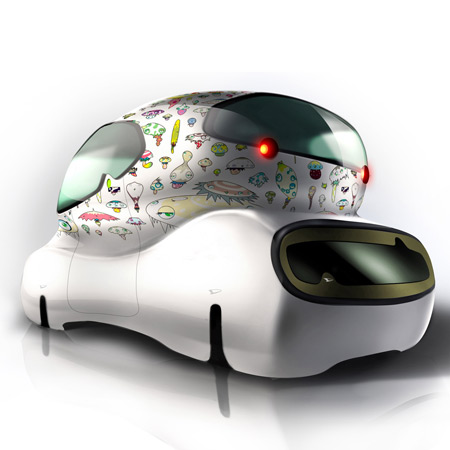
EuroK-Cars at the Royal College of Art
First year students of the Vehicle Design course at London's Royal College of Art presented concepts for light, compact cars at the Science Museum in London earlier this month.
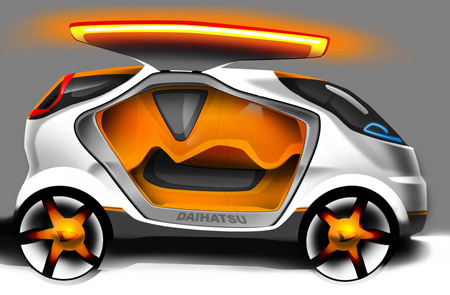
The students were asked to research Japanese light vehicles Kei cars, then design a version for a chosen European city.
Above: Augustin Barbot, 25 from France
Aimed at commuters who need to travel into the city from the rural areas. The K Car is driven onto a train which takes passengers into the city. The car can be utilised as an urban living space, either as a working office or somewhere to rest whilst users are in the city.
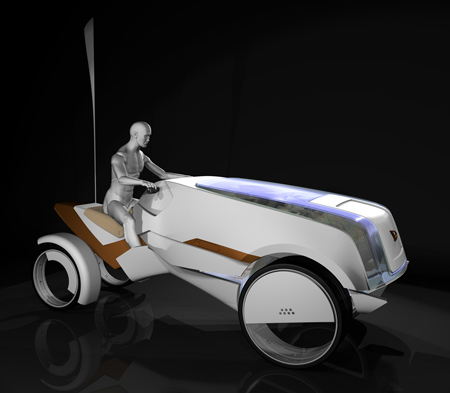
Here is a selection of the designs with captions provided by the students. The projects are on show at Japan Car, an exhibition about Japanese car design at the Science Museum that continues until 19 April.
Above: Philipp Siebourg, 28 from Germany
Originally from Bavaria, Siebourg was influenced by the annual Oktoberfest b. As the festivals get very crowded, his idea was to design a K car that could deliver beer (or other drinks such as milk) or act as a mobile bar for the public. The driver would be situated at the back of the vehicle with the load at the front.
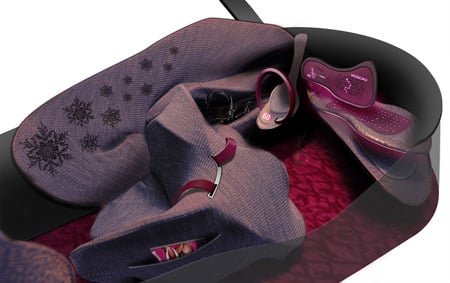
Above: Anna Geiger, 29 from Russia/Germany
Geiger grew up in Russia and aimed her car at young women living and socialisng in Moscow. Young women like to go out and meet friends after work but often live outside the city. This car could be used by women to get ready for a night out and included storage space for clothes, shoes and even a make-up mirror. The exterior could be frosted for extra privacy.
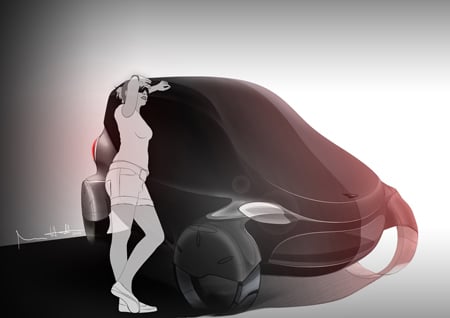
Above: Miika Heikkinen, 25 from Finland
Barcelona K Car is designed for a young Catalanian woman, who uses her car to drive tourists around the Gaudi sights and also for her leisure time. The design uses ecological materials (exterior material Soy plastic, interior material Soy fabric), Aerodynamics (low wind resistance, covered lightweight center less wheels) and over all weight. The interior elements (seats and dash) have been integrated to the car's organic shaped structure, allowing a lighter and more open exterior design for better visibility. The theatre-like rising seat layout provides good visibility for all the passengers, and some privacy for the driver.
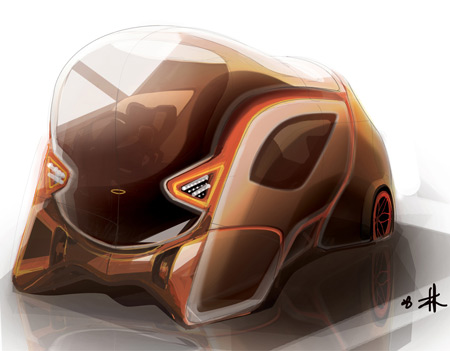
Above: Hyunjoon Park, 24 from South Korea
Urbaviva is a car suited for affluent young mothers in 2015 living in a big European city such as London. Urbaviva is made of organic materials like PLA (Poly Lactic Acid) and runs on wasted vegetable oil used at home. The interior has a specially designed baby-stroller which can slide into the car without having to take the baby out, which makes life much easier and gives a safer environment for the child.
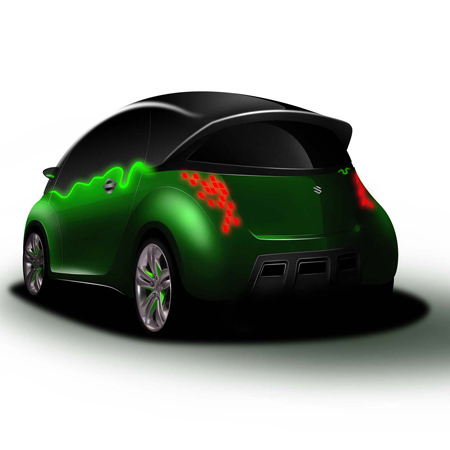
Above: Niki Merriman, 23 from England
Suzuki Londoner is aimed at professional UK males aged 25-35, as the majority of Kei cars are targeted at women. The partition line down the side of the vehicle dividing the glass and recycled plastic panel is influenced by the River Thames and the rear lights are influenced by the London skyline at night. The interior uses traditional British textiles and colours.
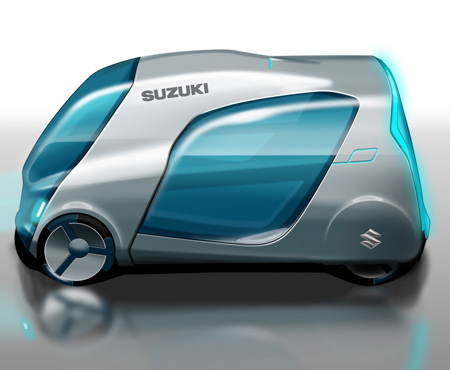
Above: Rui Guo, 21 from China
Alpine Camper is a vehicle designed for the various recreational activities for the Mountain Alps. Includes better visibility for the driver and passengers, and multi-functional performance in different environments, including camping.
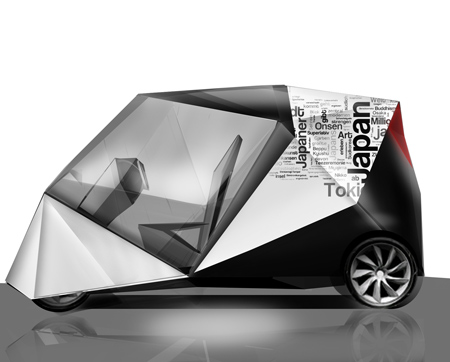
Above: Stephanie Waser, 23 from Germany
The concept Shin-Ca is inspired by the Japanese traditional art of paper folding. The exterior and interior was formed out of origami modules. The interior is a sculpture and becomes the main part of the vehicle. To create a new form language the exterior is painted with two different colours to create a dynamic feeling. The car is even controlled by a pocket monster.
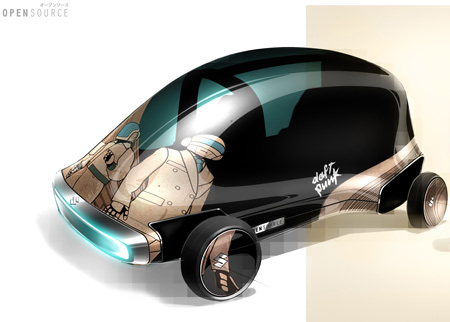
Above: Marten Wallgren, 25 from Sweden
This concept is called Open Source and is inspired by the freedom that we are given through the web. The car is an attempt to delete some of the border between our on and off-line lives. The car exterior is a huge screen/window which can be used to display websites or personal information.
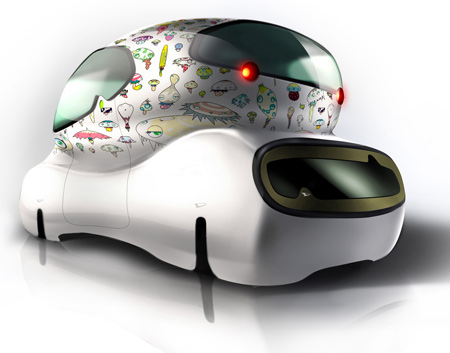
Above: Gabriel Tam, 26 from Australia
Taking inspiration from the work of contemporary Japanese artists and designers such as Takashi Murakami and Naoto Fukasawa, the AstroCar concept brings together the design philosophy of Japanese pop-art, design minimalism, and elements from Poku (Pop + otaku). By taking clean round forms and infusing a dose of "Kawaii" (Japanese for cute - a highly valued aesthetic quality in Japanese society) to the design, the AstroCar concept clearly conveys a sense of playfulness and excitement unique to the Japanese design culture.
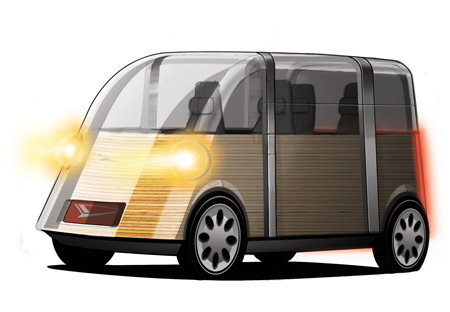
Above: Shawn Deutchman, 25 from USA
The Re is a small green vehicle inspired by Japanese Kei Cars. A young couple, exhausted by a hectic week in Paris, escape to the French country side for a rejuvenating picnic. An all glass exterior and bamboo interior aim to blend the car into the natural environment.
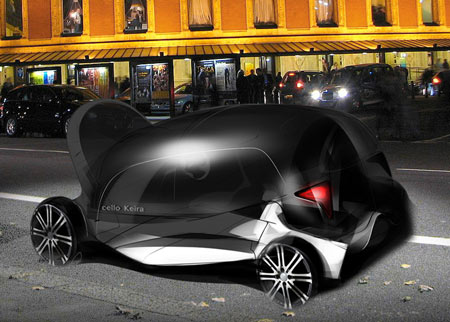
Above: Young Seong Kim, 26 from South Korea
London is a city full of energetic and creative young artists. This concept is a vehicle for a young cellist who studies in London. Classic, Lightweight structure form based on the shape of a cello.
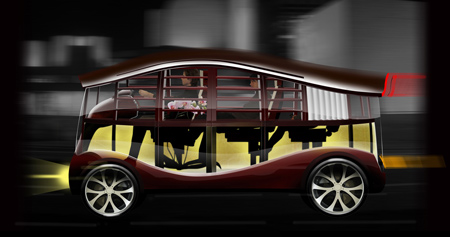
Above: Jong Won Lee, 32 from Korea
M (Meditation) car is designed for outdoor workers such as sales men or businessmen to solve their mental stress from their hectic schedule. The main inspiration is the Zen garden and traditional Japanese architectural elements.
Here's some more information about the project and brief from the college:
--
EuroK-Car
EuroK-Car is a project set within the Royal College of Art’s postgraduate Vehicle Design course, in partnership with Daihatsu and Suzuki. The results of the project coincide with the opening of the Japan Car Exhibition at the Science Museum in London.
Background
Keijidosha or Kei car means light vehicle, whether car, van or pick-up. The KeiClass is a specifically Japanese urban vehicle typology limited to 660cc capacity, tax free, parking-eligible and technologically advanced. The maximum size restrictions are as follows: length 3.4 metres; width 1.48 m; height 2 metres.
The Brief
First year Vehicle Design students were asked to research and define the KeiClass by culture, social responsibility and market, and project it into the European urban context, developing exterior and interior designs. Research and understand packaging requirements, implement new material and technological possibilities and potential drivetrain technologies. Understand the philosophy behind the Japanese Kei-car and how to interpret an aspect of Japanese car culture in a western context, within the strict packaging criteria.
Students attended seminars with representatives from Daihatsu and Suzuki – both leading manufacturers of Kei cars in Japan. The project was led by Richard Winsor, Senior Tutor in Vehicle Design at the RCA, in collaboration with Andrew Nahum, Principal Curator of Technology at the Science Museum and Research Co-ordinator within the Vehicle Design department.
Students presented their projects, which were assessed and judged by backers Daihatsu and Suzuki, to an invited audience at the museum. The projects will be exhibited alongside the Museum’s show which runs until April 19.
The word Keijidosha, or ‘Kei’ means light vehicle in Japanese, and senior tutor Richard Winsor and Professor Dale Harrow challenged Vehicle Design students to come up with designs for the compact but technologically advanced KeiClass. Students were given just 4 weeks to think about the vehicle “by culture, social responsibility and market and project their designs into an European urban context.”
The brief suggested that students bring their own backgrounds to the project. With some 15 nationalities represented among the 40 students in the department, the proposal ensured a huge variety of ideas and references.
“People come from all over the world to design in England,” said Harrow. “It’s one of our most international industries. You could have a French student come to London, go on to work for a Japanese company and be designing for a Brazilian market.”
Harrow added that with the design world's focus on the exhibition, it seemed an opportune time to look at small cars under the department’s Urban Flow module.
“The task really was to bring their own culture to this size of car. It was very challenging for the students. You would not think of a German car being this small for example. When you have a big car you’ve got a lot of space; you can even waste space. So it’s been a really exciting experiment and I am fantastically pleased with the results,” he said.
Designs ranged from bubbles to boxes, using themes from music, space fantasy, cartoons, lakes, mountains, sport and meditation. Several students experimented with seating, pitching passengers above drivers to create storage space. A spot to keep a handbag appeared to be a preoccupation but there was also room given over to guitars, babies, ski equipment and shopping in the cars whose maximum dimensions were a paltry 3400 long by 1480 wide and 2000 tall – the size of most Kei-cars.
Students used new materials including soya-based plastics to ensure sustainability in the cars whose engines, run on a variety of fuels, are limited to 660cc.
“If you had been at the college 10 years ago most students would have said they wanted to go to Germany,” Harrow said. “But now Japan design is seen as a very cool thing, one that has a very technological base. If you look at these cars there’s a lot of very original thinking. In almost every segment they’ve got something really interesting
“Japan made the modern car. It produces reliable cars for the masses when if you wanted that sort of quality in the past you had to buy an expensive German car,” he added.
“There was a time when Japanese vehicle design were just seen as copying the more established European aesthetic, but they’ve gone beyond that now and they’ve definitely got their own vision.”